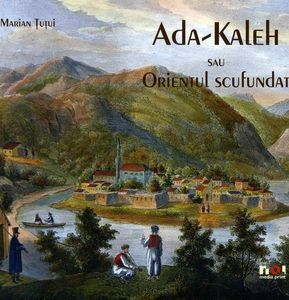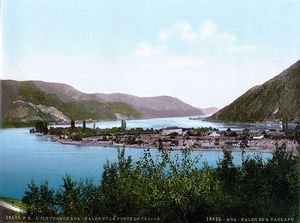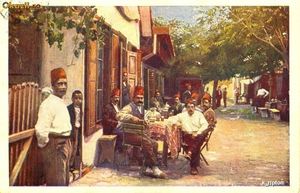Ada-Kaleh: The lost island of souls
 (Image source) Yesterday, I went to Muzeul Taranului Roman for a superb exhibition on the beautiful lost island of Ada-Kaleh, victim of the Iron Gate dam's construction in 1971. I must confess that I'd never heard of it. I was frankly shattered by what I discovered there - the total elimination of a little corner of paradise, lives lost, the forced displacement of a community, pain and dramas that simply cannot be expressed for only those displaced know how it is. Ada-Kaleh, now submerged under the waters of the Danube, lives on in souls and memories and through this marvellous exhibition.
(Image source) Yesterday, I went to Muzeul Taranului Roman for a superb exhibition on the beautiful lost island of Ada-Kaleh, victim of the Iron Gate dam's construction in 1971. I must confess that I'd never heard of it. I was frankly shattered by what I discovered there - the total elimination of a little corner of paradise, lives lost, the forced displacement of a community, pain and dramas that simply cannot be expressed for only those displaced know how it is. Ada-Kaleh, now submerged under the waters of the Danube, lives on in souls and memories and through this marvellous exhibition.
For those of you who do not know the story, the history of Ada-Kaleh (which means 'the island of the fortress' in Turkish) is long and rich. Over the centuries, the island, often disputed between ruling powers, had many names depending on who owned it - the Habsburgs, the Ottoman Empire - Yernis, Cerne, Erythia, Continusa, Cyraunis, Noua Orsova, Porizza, Carolina, Ada Kale, Ada-i-Kebir. At the height of her fame, she was known as Ada-Kaleh, and with this name she died.
With a surface of almost 2 km, the island lies 20 km from Drobeta-Turnu Severin and 4 km from the hydro dam which ultimately destroyed it.
The island has been celebrated often in world literature. It was sketched by the traveller Ferdinand de Marsigli in his Discovery of the Danube (1744), features in the novel The Golden Man by the Hungarian author Mór Jókai (1872) and also in The Danube Pilot by Jules Verne (1901). (Hungarian Review)
Accessed by boat from the mainland, Ada-Kaleh was a haven of lush vegetation (cypress, fig and olive trees) with a sublime Mediterranean climate, bathed in constant sunshine and, seen from the mountains, appeared as "a vast basket of flowers on the crystal of the Danube", says the text of my exhibition literature. How marvellous it must have been.
 (Image source) Through Constantin Severin's intense nostalgia for Ada-Kaleh where he spent his holidays as a child, we read, "We used to go by boat to the small exotic Ada Kaleh island with a Mediterranean climate and flora, 1700 long/500 wide, an oriental paradise, with around 1,000 inhabitants, most of them of Turkish origin. All of them grew up in the light of a strange and very ancient oath of allegiance: those who left the island had to come back to die and be buried at home - the island with catacombs haunted by children or ghosts, the island with strong and passionate love stories, the island with a vivid and spectacular history of over 2000 years, from the Roman empire epoch.
(Image source) Through Constantin Severin's intense nostalgia for Ada-Kaleh where he spent his holidays as a child, we read, "We used to go by boat to the small exotic Ada Kaleh island with a Mediterranean climate and flora, 1700 long/500 wide, an oriental paradise, with around 1,000 inhabitants, most of them of Turkish origin. All of them grew up in the light of a strange and very ancient oath of allegiance: those who left the island had to come back to die and be buried at home - the island with catacombs haunted by children or ghosts, the island with strong and passionate love stories, the island with a vivid and spectacular history of over 2000 years, from the Roman empire epoch.
I remember with special nostalgia the white mosque in the middle of this magical place, the oriental architecture of the houses and the narrow streets with Medieval stones, the ruins of an Austrian fortress built in the 18th century, the kind people who sold us delicious Turkish delight, millet beer, khalva, nougat or the unique rose jam. My parents sat on a terrace to drink the coffee boiled on fine sand and smoke tobacco from the nargilehs..." Idyllic.
 (Photo source: Ada-Kaleh bazaar) What is strange is that the fate of Ada-Kaleh and her inhabitants had very little press coverage. Under communism, such news would not have been allowed to make the press, but afterwards, why has there been so little attention given to it - and in Europe at that. It seems I'm not the only person who had never heard of this enchanting place.
(Photo source: Ada-Kaleh bazaar) What is strange is that the fate of Ada-Kaleh and her inhabitants had very little press coverage. Under communism, such news would not have been allowed to make the press, but afterwards, why has there been so little attention given to it - and in Europe at that. It seems I'm not the only person who had never heard of this enchanting place.
In the sixties, before Ada-Kaleh found herself submerged, her population ranged between 600 and 1,000 inhabitants. The exhibition shows how very tightly knit the community was, how Turks and Romanians, muslims and orthodox christians, lived together in friendship, loyalty and harmony. At this time, Ada-Kaleh had two large factories (one a clothing manufactory and the other for tobacco), an electric power company, two places of worship (one muslim, one orthodox), several notable coffee houses, restaurants and a cinema. At the weekend and peak seasons, the island was filled to bursting point with countless tourists attracted by the exoticism, the incomparable taste of fig and rose jams, the Turkish delight and the aromatic cigarettes - not to mention the sheer natural beauty... The population lived primarily on the cultivation of tobacco and fishing, and later on, tourism.
 (Image source) The Ada Kaleh Mosque, dating from 1903, was built on the site of an earlier Franciscan monastery. The carpet of the mosque, a gift from the Turkish Sultan Abdülhamid II, was relocated to Constanta Mosque in 1965.
(Image source) The Ada Kaleh Mosque, dating from 1903, was built on the site of an earlier Franciscan monastery. The carpet of the mosque, a gift from the Turkish Sultan Abdülhamid II, was relocated to Constanta Mosque in 1965.
So, what happened to Ada-Kaleh? It was submerged during the construction of the Iron Gates hydroelectric plant in 1970. The Hydropower Iron Gates project was officially inaugurated in 1964 - a joint venture between Romania and the former Yugoslavia. Between 1967-1970, all the buildings on the island were demolished. The inhabitants were forced to leave, having seen their homes, livelihoods and childhoods wiped out.
Nick Thorpe writing for The Hungarian Review on 15th September 2011 describes a meeting of top Romanian and Yugoslav communist officials some time in 1967:
Thorpe continues: The most traumatic memories, apart from the day he witnessed the actual destruction of the main buildings, involve digging up the graveyard. “That was still during the period when we all expected to be moved to Simian Island. So each grave had to be dug up individually.” His own mother died during the period of moving, and he buried her immediately on Simian, in the expectation that he would soon be living close by.
Such pain...
Thorpe ends: Back in Orsova, I leave Ahmed Engur chopping wood – great slices of plane tree that were unloaded on his doorstep that morning.
The cruel irony of it.
 (Photo: Muzeul Naţional al Ţăranului Român) With the building of the hydropower dam, the level of the Danube rose 40m, covering beautiful Ada-Kaleh. That stunning 'basket of flowers on the crystal of the Danube' was swallowed up forever, and with it, centuries of history. The communists knew what would happen but it was of no importance to them whatsoever. Despite tourism being the great success that it was, along with the fact that under G.G Dej, Ada-Kaleh had become an important economic contributor through its clothing manufactory, they killed it anyway. Destruction for destruction's sake - just as we see today. If it's lovely, if it's beautiful, destroy it. This is a legacy not yet shed...
(Photo: Muzeul Naţional al Ţăranului Român) With the building of the hydropower dam, the level of the Danube rose 40m, covering beautiful Ada-Kaleh. That stunning 'basket of flowers on the crystal of the Danube' was swallowed up forever, and with it, centuries of history. The communists knew what would happen but it was of no importance to them whatsoever. Despite tourism being the great success that it was, along with the fact that under G.G Dej, Ada-Kaleh had become an important economic contributor through its clothing manufactory, they killed it anyway. Destruction for destruction's sake - just as we see today. If it's lovely, if it's beautiful, destroy it. This is a legacy not yet shed...
For further reading on Ada-Kaleh (in Romanian), please see Romania Libera and Mircea Rusnac – Perla pierdută a Banatului: Ada-Kaleh. It is a story in need of telling far and wide, and, like so many other tragedies that took place under communism, never, ever forgotten...
The exhibition, Ada Kaleh, Insula din Suflet can be seen in Bucharest at Muzeul Naţional al Ţăranului Român in Sala Foaier until 19th August Tuesday-Sunday from 10h-18h (free entrance) and then moves to Muzeul de Istorie Naţională şi Arheologie in Constanţa (14 - 28 September 2012) and Muzeul Regiunii Porţilor de Fier in Drobeta-Turnu Severin (9 - 31 October 2012). You'll regret missing it.
Congratulations and thanks to the curators Rodica Marinescu, Carmen Mihalache and project co-ordinator, Magda Andreescu. Without them, I would have surely continued to live in ignorance.

/https%3A%2F%2Fstorage.canalblog.com%2F03%2F12%2F353913%2F41915630_o.jpg)
/https%3A%2F%2Fstorage.canalblog.com%2F15%2F06%2F353913%2F41915331_o.jpg)
/https%3A%2F%2Fstorage.canalblog.com%2F03%2F68%2F353913%2F41914713_o.jpg)
/https%3A%2F%2Fstorage.canalblog.com%2F22%2F12%2F353913%2F29890995_o.jpg)
/https%3A%2F%2Fstorage.canalblog.com%2F68%2F41%2F353913%2F29890862_o.jpg)


/https%3A%2F%2Fstorage.canalblog.com%2F08%2F12%2F353913%2F116988178_o.jpg)
/https%3A%2F%2Fstorage.canalblog.com%2F59%2F38%2F353913%2F115811794_o.jpg)
/https%3A%2F%2Fstorage.canalblog.com%2F00%2F54%2F353913%2F113969303_o.jpg)
/http%3A%2F%2Fp8.storage.canalblog.com%2F81%2F17%2F353913%2F59684501_p.jpg)